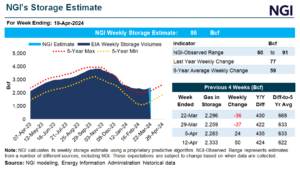Traders Anticipating Double-Digit Injection as Natural Gas Futures Called Slightly Higher
As traders prepared for the potentially pivotal release of the latest government storage data, natural gas futures were up modestly in early trading Thursday. The August Nymex contract was trading at $1.694/MMBtu at around 8:45 a.m. ET, up 2.3 cents.

Coming off a plump 120 Bcf injection reported a week earlier, analysts anticipate a much smaller double-digit injection from today’s Energy Information Administration (EIA) storage report, which covers the week ended June 26.
A Bloomberg poll found injection estimates ranging from 68 Bcf to 85 Bcf, with a median of 78 Bcf. A Wall Street Journal survey produced estimates spanning 66 Bcf to 85 Bcf and an average of 79 Bcf. Estimates by analysts polled by Reuters ranged from 69 Bcf to 93 Bcf, with a median of 78 bcf. NGI estimated a 71 Bcf build for the report, which is scheduled for 10:30 a.m. ET.
The forecasts compare with a reported 92 Bcf injection in the same week a year earlier and a five-year average build of 65 Bcf.
“It was very warm to hot over most of the country besides the cooler central U.S./Plains” during this week’s EIA report period, according to NatGasWeather. “Our algorithm predicts a build of 68 Bcf, to the bullish side.”
Genscape Inc. analysts predicted a 67 Bcf injection from EIA this week, reflecting a “seasonally-adjusted composite” of supply and demand modeling indicating a 58 Bcf build and storage facility sample modeling pointing to a refill of 69 Bcf.
“Compared to degree days and normal seasonality, a 67 Bcf injection would appear tight versus the previous five-year average by 0.3 Bcf/d,” the firm said in a note to clients early Thursday.
The latest EIA report presents traders considering long positions with a tricky decision, according to analysts at EBW Analytics Group.
“Major surveys call for a build of 75-79 Bcf. Heading into the holiday weekend, when cash demand is likely to be weak, this might drive the August contract down by several cents,” the EBW analysts said. “But a much smaller build is possible, potentially as low as 67-69 Bcf. With many traders already taking off for the weekend, this could ignite a significant rally.”
As for the overnight guidance, NatGasWeather observed “mixed results” from the major models, including a “minor” loss of around 2-3 cooling degree days from the European model’s outlook.
“No changes overall as a rather hot U.S. pattern remains on track through the middle of next week, but more impressively so” from next week through July 15 when upper high pressure is expected to strengthen and result in highs of 90s over most of the United States, the forecaster said. “This is expected to increase power burns to 40-45 Bcf/d and drop builds to as small as 10-20s Bcf for mid-July.”
August crude oil futures were up 42 cents to $40.24/bbl at around 8:45 a.m. ET, while August RBOB gasoline was up about 1.5 cents to $1.2315/gal.
© 2024 Natural Gas Intelligence. All rights reserved.
ISSN © 1532-1231 | ISSN © 2577-9877 |


